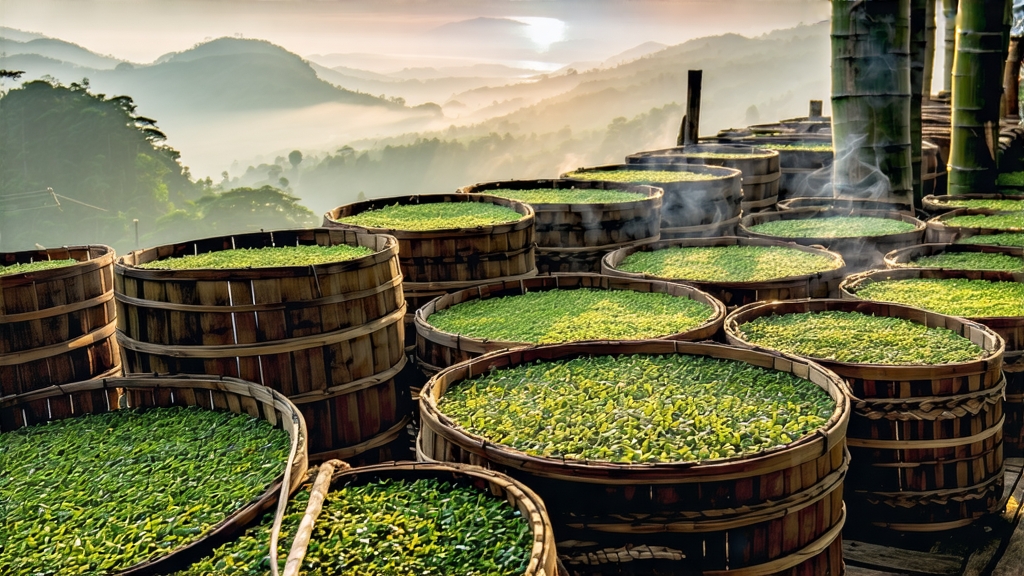
When European tea lovers first encountered the bold, smoky aroma of Lapsang Souchong in the early seventeenth century, they were tasting the very prototype of black tea. Known in China as Zheng Shan Xiao Zhong, this extraordinary leaf from the Wuyi Mountains of northern Fujian province predates every other black-tea style on earth. Its story is one of rugged landscapes, accidental invention, imperial favor, and, eventually, global obsession. Today, whether you sip the traditional pine-smoked version or the newer, unsmoked “wild” variant, you are drinking liquid history—an amber bridge that connects Qing-dynasty caravans to twenty-first-century specialty cafés.
Origin and Terroir
The Wuyi range is a UNESCO World Heritage site where 400-million-year-old granite cliffs rise above a maze of narrow gorges. Morning mists linger between these cliffs, diffusing sunlight and trapping cool, moist air ideal for slow leaf growth. The mineral-rich, sandy-loam soil—locally called “rock soil”—forces tea bushes to send roots deep into crevices, absorbing trace elements that translate into the famous “yan yun” or “rock rhyme,” a lingering stony note prized in all Wuyi teas. Lapsang Souchong is harvested from a cluster of indigenous cultivars—Xingcun Xiaozhong, Wuyi Caicha, and the rare vegetable-scented Qizhong—growing at 600–1,200 m elevation inside a 60 km² core protected zone known as Zheng Shan, literally “Original Mountain.” Only leaf picked within this perimeter may bear the authentic name.
A Tale of Two Leaves
There are now two distinct families under the Lapsang umbrella. The classic Smoked Lapsang is withered over burning pine logs in an ancient wooden house called a qinglou; the newer Unsmoked (or “Wild”) Lapsang is processed in the same way but dried with hot air, allowing the natural honey, longan, and lychee aromatics of the leaf to dominate. Both styles share the same plucking standard—one bud and two or three leaves picked in the brief spring window between Qingming and Guyu—but diverge dramatically in the finishing stage.
Crafting the Smoke
To understand Lapsang Souchong is to follow pine smoke. After plucking, the leaves are laid on bamboo trays suspended above a ground-level firebox filled with local Masson pine. The resinous heartwood smolders at 40–45 °C for 8–10 hours, infusing the still-moist leaf with volatile guaiacol and syringol compounds. Once the leaf reaches 60 % moisture loss, it is rolled on rattan mats to rupture cell walls, then oxidized for 3–4 hours in wooden barrels lined with wet cloth. A second, hotter smoking at 70 °C fixes the color and aroma. Master smokers judge readiness not by clock but by scent: the moment the tea exudes a sweet resinous note reminiscent of candied bacon, it is rushed to a cooling room. The entire process consumes 4 kg of pine for every kilogram of finished tea, a ratio unchanged since the Tongzhi Emperor’s reign (1862–1874).
Unsmoked Innovation
In 2005, a small group of Wuyi artisans, led by master Jiang Yuanxun, wondered what the leaf would taste like without its pine cloak. They built charcoal-heated ovens lined with clean copper sheets and dried the oxidized leaf at 85 °C for two hours. The result shocked locals: a bright burgundy liquor tasting of dried longan, raw honey, and a faint cooling mint that echoed the cliff orchids blooming nearby. Dubbed “Wild Lapsang,” it fetched ten times the price of smoked versions at the Guangzhou tea fair and inspired a new generation of terroir-driven black teas throughout China.
Chemical Signature
Gas-chromatography analysis reveals that smoked Lapsang contains up to 3.2 mg/kg guaiacol and 1.8 mg/kg 4-methylguaiacol, compounds responsible for its campfire bouquet. Unsmoked lots, by contrast, show high levels of hotrienol and geraniol, floral volatiles also found in Taiwanese oolongs. Both styles are rich in theaflavins (12–18 % of dry weight) and low in caffeine (2.2–2.8 %), making them gentle on the